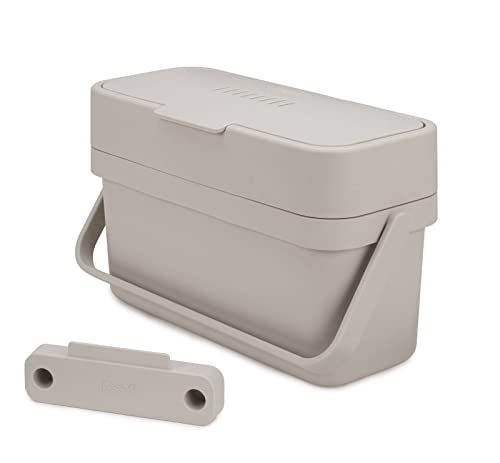
Lomi Kitchen Composter
| Pros | Cons |
|---|---|
|
|
Our content is meticulously curated through independent research, testing, reviews, and AI-driven recommendations, all designed to present you with the finest product choices. When you make a purchase through our links, it could result in us earning a commission.

When it comes to cooking and consuming food, there's a high chance for a pileup of leftover food scraps that we mindlessly toss in the garbage can. But did you know that food waste can be useful for the environment? Check out kitchen composters! These devices allow you to turn your kitchen waste into valuable compost, ideal for fertilizing your plants and reducing your carbon footprint. In this guide, we will share the best kitchen composters of 2024 that are easy to use and compact. The Lomi Kitchen Composter may be small, but it's big on simplicity and odor removal.
Now that you are familiar with the top kitchen composters in today’s market, let’s get started with what makes a kitchen composter worthy of being in the top choices. Here’s a short guide on everything you need to know about these handy devices.
A kitchen composter is a simple and effective way to reduce your food waste. They can also help reduce methane emissions from landfills, as well as reduce the amount of water needed to irrigate your plants. But, how do these composters work? A kitchen composter typically has two chambers, so you can add food scraps to one chamber while the other chamber is “composting” or breaking down those food scraps into nutrient-rich compost. Some kitchen composters even have filters to reduce odor. The process of decomposition is accelerated in a kitchen composter because of the warmth and moisture generated by the rotting food scraps. Aerobic bacteria thrive in these conditions and go to work breaking down the organic matter into simpler compounds that can be used as nutrients for plants. As the chamber fills up with finished compost, you can empty it into your garden or yard, where it will provide valuable nutrients for your plants.
Bokashi bin composters are perfect for small households or those who don’t have a lot of counter space. These types of kitchen composters come in a variety of sizes, but they all work using the same principle: layering food scraps with an aerobic fermentation process that breaks down the food without producing odors. Bokashi bins typically have a spigot at the bottom so you can drain off any excess liquids, which can then be used as plant fertilizer.
Compost crocks and pails are some of the most popular types of kitchen composters since they’re aesthetically designed and easy to use. Like bokashi bins, crocks, and pails use layering to break down food scraps. Rather than using anaerobic fermentation, these composters rely on microorganisms to break down the organic matter.
Most kitchen composters have a capacity of just a few gallons, but some larger models can hold up to four gallons. If you have a large family or you do a lot of cooking, consider choosing a larger model so you can compost all of your food waste. If you live independently or have a little family, a smaller model will suffice. You can find out the size of a kitchen composter in its product description. It will either be given in gallons or liters.
Some composters are made to sit on your countertop, while others can be mounted under your sink. If you're short on counter space, go with a composter that can be mounted under your sink. If you have an abundance of counter area, any type of composter will work. If you do decide to opt for an over-the-counter design, make sure the composter is built aesthetically and matches your kitchen's interior.
You'll also want to consider how easy the composter is to use. Some models come with filters that need to be changed regularly, while others have self-contained filters that never need to be changed. Choose a model that's easy to use and low maintenance so you can stick with composting. You can get a good idea about a kitchen composter's user-friendliness by going through some customer testimonials on the product page.
Of course, price is also a significant consideration. Kitchen composters vary in cost from $30-$100 depending on the features and capacity. Choose the most reasonable option that meets your needs and budget.
Every year, millions of tons of nutritional waste end up in trash yards where they decompose and radiate methane, a greenhouse gas that contributes to environmental change. By composting your food waste instead of tossing it out, you can help lessen methane emissions and do your part to slow down climate change.
If you keep a garden, then you might be aware of how crucial it is to use the right fertilizer so your plants will prosper strong and healthy. Unfortunately, many commercial fertilizers are full of harmful chemicals that can pollute the environment and even contaminate drinking water supplies. When you compost your kitchen scraps, you create a nutrient-rich soil amendment that you can use to fertilize your garden without worrying about harming the environment.
Did you know it takes a lot of water to produce the food we eat? In fact, according to the U.S. Geological Survey, it takes an average of 1,847 gallons of water to produce just one pound of beef. By composting your food leftovers instead of tossing them away, you can help diminish your water footprint and save this precious resource.

| Pros | Cons |
|---|---|
|
|

| Pros | Cons |
|---|---|
|
|

| Pros | Cons |
|---|---|
|
|

| Pros | Cons |
|---|---|
|
|

| Pros | Cons |
|---|---|
|
|